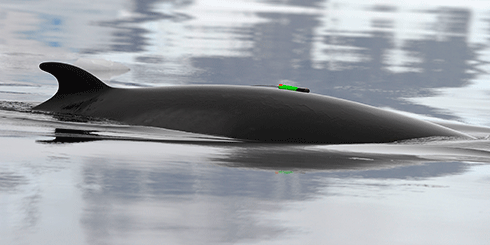
|
Published: 28 April 2014
Southern Ocean 'duck' turns out to be minke whale
Scientists have conclusive evidence that the source of a unique rhythmic sound – recorded for decades in the Southern Ocean and called the ‘bio-duck’ – is the Antarctic minke whale (Balaenoptera bonaerensis). The finding will enable researchers to discover more about this little understood species.

|
|
A tagged minke whale in Antarctic waters. Credit:
AS Friedlaender, Oregon State University
|
First described and named by submarine personnel in the 1960s who thought it sounded like a duck, the bio-duck sound has been recorded at various locations in the Southern Ocean, but its source has remained a mystery. It was thought to be made by submarines, by an oceanographic phenomenon, or even by fish.
In February 2013, an international team – which included researchers from the Australian Antarctic Division – deployed acoustic tags on two Antarctic minke whales in Wilhelmina Bay off the western Antarctic Peninsula.
Acoustic analysis of the data, which contained the bio-duck sound, was led by Denise Risch of NOAA's Northeast Fisheries Science Center (NEFSC) in the US, and was published in Biology Letters.
The bio-duck sound is heard mainly during the austral winter in the Southern Ocean around Antarctica and off Australia's west coast.
Described as a series of pulses in a highly repetitive pattern, the bio-duck's presence in higher and lower latitudes during the winter season also contributed to its mystery. No one knew the minke whales were there.
The identification of the Antarctic minke whale as the source of the sound now indicates that some minke whales stay in ice-covered Antarctic waters year-round, while others undertake seasonal migrations to lower latitudes.
‘These results have important implications for our understanding of this species,’ said Risch, a member of the Passive Acoustics Group at the NEFSC's Woods Hole Laboratory.
‘We don't know very much about this species, but now, using passive acoustic monitoring, we have an opportunity to change that, especially in remote areas of the Antarctic and Southern Ocean.’
Animals carrying the acoustic tags, which also recorded water temperature and pressure, were visually tracked from a boat during daylight hours to identify behaviour and group composition.
No other marine mammal species were observed in the area when calls were recorded, providing further evidence that the recorded sounds were produced by the tagged whale or other nearby Antarctic minke whales.
Findings from this study will allow researchers to interpret long-term acoustic recordings, and improve understanding of the distribution, abundance, and behaviour of this species.
Minke whales are the smallest of the ‘great whales’ or rorquals, a group that includes the blue whale, Bryde's whale, and humpback, fin, and sei whales. Rorqual whales are relatively streamlined in appearance, have pointed heads and, with the exception of humpback whales, small pointed fins.
The researchers note that identifying the bio-duck sound will allow for broader studies of the presence of minke whales in other seasons and areas.
That ability to monitor minke whales is critical for a species that inhabits an environment that is difficult to access, has rapidly changing sea-ice conditions, and ‘has been the subject of contentious lethal sampling efforts and international legal actions.’
Source: NOAA



